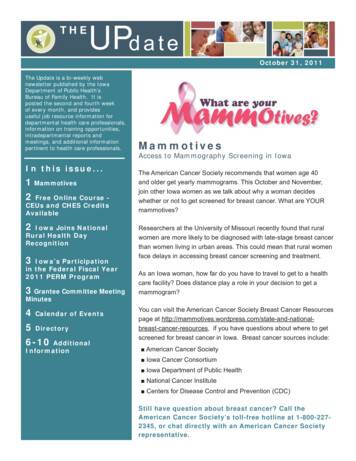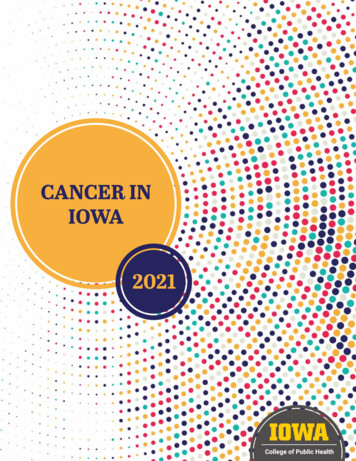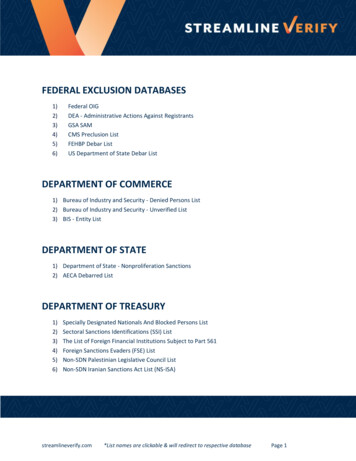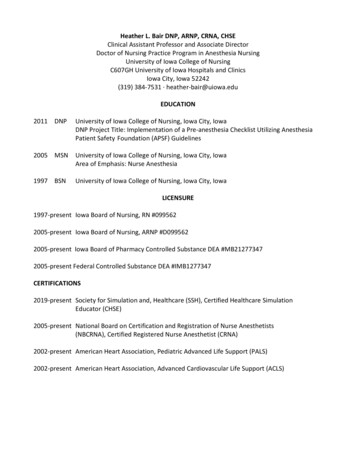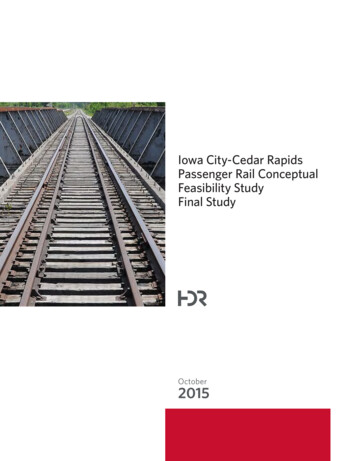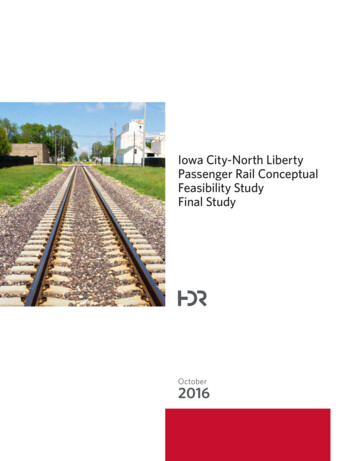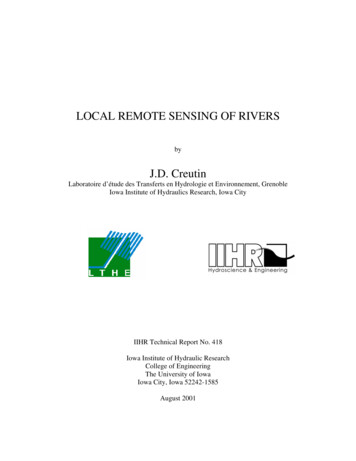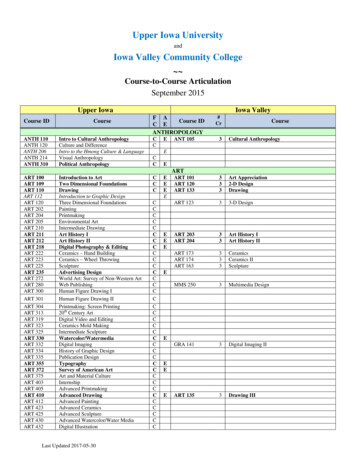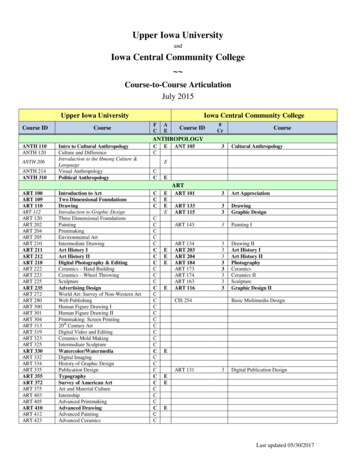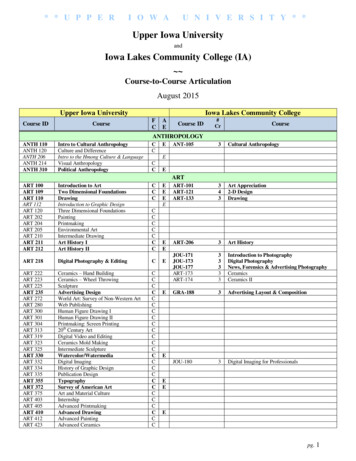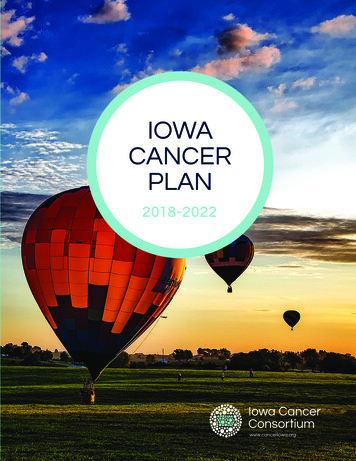
Transcription
IOWACANCERPLAN2018-2022INTRODUCTION TO THE IOWA CANCER CONSORTIUM1
Dear people of Iowa,As President of the Iowa Cancer Consortium Board of Directors, it is myhonor and pleasure to introduce the 2018-2022 Iowa Cancer Plan. This is thefourth such plan developed by the Consortium beginning with our first planpresented to the State of Iowa in 2003.George Weiner, M.D.President, Board of Directors,Iowa Cancer ConsortiumWe have made significant progress in some areas of cancer control inIowa based on initiatives that were outlined in the prior cancer controlplans. Deaths from the most common cancers - lung, colorectal, breastand prostate cancer - have dropped steadily (albeit not fast enough). Thereis increasing acceptance of the importance of tobacco cessation, physicalfitness, screening for cancers including colorectal and breast cancer, HPVvaccination and testing for radon as ways to reduce the burden of cancer.Yet, there is still much to be done. There are still too many preventabledeaths from cancer in Iowa. We could reduce the death rate from cancerin Iowa by over one-third if we fully applied what we already know aboutcancer control. Some populations in Iowa have a particularly high burdenof cancer, and there is more that can and should be done to addressthese cancer disparities. In addition, cancer research is progressing at anunprecedented rate, and we need to continue to invest in cancer researchin our state. This research will provide new tools that will help reduce theburden of cancer even further through improved prevention, early detectionand therapy.This cancer plan was developed over many months by dedicated teamsof experts with a broad variety of backgrounds, including public healthprofessionals, social scientists, epidemiologists, cancer researchers,oncologists, other cancer clinicians and patient advocates.We owe it to the people of Iowa to do everything we can to work togetherto further reduce the burden of cancer now and for future generations.This plan describes how.Sincerely,George Weiner, M.D.President, Board of Directors, Iowa Cancer Consortium22018-2022 IOWA CANCER PLAN
Dear Iowans,Dear Iowans,Development of a plan and engaging key partners is key tosuccessful community-based interventions which focus onimproving health of Iowans. For 17 years, the Iowa CancerConsortium has led Iowa’s efforts in understanding cancer’simpact on Iowans, as well as the identification of interventionswhich reduce the impact of cancer on our residents.I want Iowa to be the healthiest state in the nation. Key to thatgoal is combating the second-leading cause of death in Iowa,cancer. The Iowa Cancer Plan is a diverse and collaborativeeffort to establish Iowa’s vision to combating cancer over thenext five years.As the second leading cause of death among Iowans, canceris a significant public health issue for our state. Successfulinterventions require the engagement of community-basedresources, healthcare providers, families, and numerousother partners.And we have proven strategies that reduce the burden ofcancer. For example, we know that avoiding tobacco usereduces cancer risk. Having regular cancer screenings canhelp find precancerous changes and cancers at their earlieststages when prevention and treatment can be easier and moreeffective. Research also suggests that getting exercise, eatingfruits and vegetables, and receiving certain vaccinations also areproven strategies which not only improve health generally, butare associated with reduced cancer risk.The development of the Iowa Cancer Plan assists publicpolicymakers, community-based organizations, healthcareproviders, and all Iowans to harness energies to focus oneffective strategies ranging the continuum from preventionthrough treatment and survivorship. Strong partnerships anda continued investment in cancer control and prevention willensure a future where cancer is no longer a burden for Iowans.I commend this plan to Iowans impacted and interestedin reducing cancer’s burden. A community informed is acommunity armed with the tools necessary to make Iowa thehealthiest state in the country.It is important we have a comprehensive cancer controlplan in place, however let us not lose sight of the thousandsof Iowans whose lives have been taken by cancer. Theirstories sometimes are heart wrenching and always moving.Throughout this plan, you will find stories of Iowans whohave been affected by cancer.The Iowa Cancer Plan, newly revised for 2018-2022, is a guidefor cancer control practices across the state. It is also a toolfor you as an Iowan. Because we are all changed by cancer, wemust all work together to conquer it. You can do so much: Share the stories and information within this plan. Share your own story. Participate in cancer control in any way you can. Join the Iowa Cancer Consortium. Advocate for resources and encourage partnerships in thefight against cancer.I commend the Iowa Cancer Consortium, its partners, and thepassionate individuals and organizations on their collaborativeefforts to reduce the burden of cancer for all Iowans. Toensure a healthier future for all Iowans, we must continue tohear one another’s stories, tell our own, and most importantly,work together to conquer cancer.Sincerely,Sincerely,Kim ReynoldsGovernor of IowaGerd W. Clabaugh, MPADirector, Iowa Department ofPublic Health2018-2022 IOWA CANCER PLAN3
TABLE OF CONTENTSDedication and Acknowledgements . . . . . . . . . . . . . . . . . 5Introduction to the Iowa Cancer Consortium . . . . . . . . . . . . . 6Introduction to the 2018-2022 Iowa Cancer Plan. . . . . . . . . . . 8Who Should Use This Plan? . . . . . . . . . . . . . . . . . . . . . 9A Picture of Iowa’s Cancer Incidenceand Mortality Rates Over Time. . . . . . . . . . . . . . . . . . . . 102018-2022 Iowa Cancer Plan Priorities1. Prevention . . . . . . . . . . . . . . . . . . . . . . . . . . . 122. Screening . . . . . . . . . . . . . . . . . . . . . . . . . . . 133. Treatment . . . . . . . . . . . . . . . . . . . . . . . . . . . 144. Quality of Life . . . . . . . . . . . . . . . . . . . . . . . . . 145. Health Equity . . . . . . . . . . . . . . . . . . . . . . . . . 15Goals, Actions, Data Targets and Cancer Stories:Goal 1: Collaboration . . . . . . . . . . . . . . . . . . . . . . 16Goal 2: Tobacco and Nicotine . . . . . . . . . . . . . . . . . . 18Goal 3: Physical Activity and Nutrition . . . . . . . . . . . . . . 20Goal 4: Alcohol . . . . . . . . . . . . . . . . . . . . . . . . . . 21Goal 5: Vaccines to Prevent Cancer . . . . . . . . . . . . . . . 22Goal 6: Ultraviolet (UV) and Sun Safety . . . . . . . . . . . . . 24Goal 7: Radon and Environmental Substances . . . . . . . . . 26Goal 8: Cancer Risk Assessment . . . . . . . . . . . . . . . . 27Goal 9: Cancer Screening . . . . . . . . . . . . . . . . . . . . 28Goal 10: Access and Treatment . . . . . . . . . . . . . . . . . 30Goal 11: Cancer Workforce . . . . . . . . . . . . . . . . . . . 32Goal 12: Research and Clinical Trials . . . . . . . . . . . . . . 33Goal 13: Quality of Life . . . . . . . . . . . . . . . . . . . . . . 34Goal 14: Health Equity . . . . . . . . . . . . . . . . . . . . . . 36Goal 15: Data and Evaluation . . . . . . . . . . . . . . . . . . 37PLEASE NOTE:Evaluation of the Cancer Plan . . . . . . . . . . . . . . . . . . . . 38Items in bold are defined inthe glossary on page 39.Glossary . . . . . . . . . . . . . . . . . . . . . . . . . . . . . . . 3942018-2022 IOWA CANCER PLANReferences . . . . . . . . . . . . . . . . . . . . . . . . . . . . . . 44
DEDICATION AND ACKNOWLEDGEMENTSThe 2018-2022 Iowa Cancer Plan is dedicated to the people of Iowa whose lives havebeen touched by cancer. These Iowans are the faces of cancer in Iowa and inspire acollaborative effort to reduce the burden of cancer in our state.This plan was created in a spirit of collaboration, and is the result of the work and inputof many Iowans. We would like to extend a very sincere thank you to the followingpeople for their passion and efforts in creating the 2018-2022 Iowa Cancer Plan:Iowa Cancer Plan SteeringCommittee membersSieglinde Prior, MA, MPH, Iowa Departmentof Public Health Division of Tobacco UsePrevention and ControlIowa Cancer Consortium Board ofDirectorsNatoshia Askelson, MPH, PhD, University ofIowa College of Public HealthDenise Attard Sacco, MPH, CHES, IowaDepartment of Public Health Bureau ofChronic Disease and ManagementGeorge Weiner, MD, President, University ofIowa Holden Comprehensive Cancer CenterVictoria Brenton, BLS, Iowa Department ofPublic Health Bureau of Chronic Disease andManagementKaren Buechler, MPH, ARNP, CIC, IowaDepartment of Public Health Bureau ofChronic Disease and ManagementEmily Sarcone, MPH, CHES, CHI Health LauraSeegmiller, MPH, University of Iowa Collegeof Public HealthRichard L. Deming, MD, Vice President, MercyCancer Center – Des MoinesNorm Van Klompenburg, MSW, Treasurer,Community VolunteerRachel Schramm, MS, CHES, Linn CountyPublic HealthKaren Van De Steeg, MA, Secretary, June E.Nylen Cancer CenterDon Callaghan, Iowa Department of PublicHealth Immunization ProgramAlyson R. Simmons, Family Planning Councilof IowaMary Charlton PhD, University of Iowa Collegeof Public Health, Iowa Cancer RegistryAshley Christensen, Upper ExplorerlandRegional Planning CommissionNoah Tabor, Esq, American Cancer SocietyCancer Action NetworkJason Daniel-Ulloa MPH, PhD, University ofIowa College of Public HealthTina Devery, MHA, University of Iowa HoldenComprehensive Cancer CenterBeth Turner, MA, CHES, American LungAssociationGabbi Dewitt BA, Black Hawk County HealthDepartmentR. William Field, PhD, MS, University of IowaCollege of Public HealthSusan Vileta, Johnson County Public HealthCindy Fiester BA, BSN, RN, Linn CountyPublic HealthPaul Gilbert, PhD, ScM, University of IowaCollege of Public HealthPatty Grossnickle, RN, UnityPoint Health FortDodge Trinity Cancer CenterJami Haberl, MPH, MHA, Iowa Healthiest StateInitiativeRichard Hoffman, MD, MPH University of IowaCarver College of Medicine, University ofIowa Holden Comprehensive Cancer CenterDaniel Hoffman-Zinnel, EdD, One IowaJeanna Jones, Iowa Department of PublicHealth Bureau of Chronic Disease andManagementKatie Jones, MPH, Iowa Department of PublicHealth Bureau of Chronic Disease andManagementBethany Kintigh, RN, BSN, Iowa Departmentof Public Health Immunization ProgramCharles Lynch, MD, PhD, University of IowaDepartment of Epidemiology, Iowa CancerRegistryBradley McDowell, PhD, University of IowaHolden Comprehensive Cancer CenterJessica Nelsen, MPA, Susan G. Komen GreaterIowaCarol Voss, MEd, RDN, LD, Iowa Departmentof Public Health Bureau of Nutrition andHealth PromotionKimberly Ivester MS, BSN, RN OCN, Helen G.Nassif Community Cancer CenterSarah Taylor Watts, MPA, PAPHS, IowaDepartment of Public Health Bureau ofNutrition and Health Promotion MelissaWright, LMSW, OSW-C, Gilda’s Club QuadCitiesChristine Manternach MBA, American CancerSocietyJanice Edmunds Wells, BS, MSW, CPH, Retired,Former Iowa Department of Public Health,Office of Minority and Multicultural HealthVincent Reid MD, FACS, Mercy Medical Center,Cedar RapidsMichele West, PhD, University of IowaDepartment of Epidemiology, Iowa CancerRegistryRudy Papakee MHA, Meskwaki Tribal HealthCenterIowa Cancer Consortium currentand past staffTessa AllredThe generous individuals whoshared their cancer storiesAllie Bain, MPHMeg Beshey, Fort DodgeAmanda Carlson ReimannDavid McCluskey, West Des MoinesKelly RollinsPamela Codd, Iowa CityMeagan Schorr, MPH, CHESCathy Ketton, Niisha and ShanQuieshaRobinson, WaterlooLindsay SchultzLevi LappinKelly Wells Sittig, CCPHJill Lightfoot, BettendorfPaula Schnack, Oakland2018-2022 IOWA CANCER PLAN5
Introduction to theIowa Cancer ConsortiumThe Iowa Cancer Consortium is a statewidenonprofit coalition of health care providers, publichealth professionals, caregivers, researchers,cancer survivors, volunteers and advocates workingtogether to reduce the burden of cancer in Iowa.WHAT DOES THE CONSORTIUM DO? Establishes and grows partnershipsbetween individuals and organizations,enhancing partners’ abilities to addresscancer issues. Provides a neutral setting for agenciescompeting for the same funding andpatient base to work together to reduceduplication of efforts and advancecommon cancer control issues.There is a role at the Iowa CancerConsortium for every Iowan. Learn moreat www.canceriowa.org/membership. Leverages state and federal funds to thefullest extent by using the expertise ofvolunteers and members. Provides capacity buildingopportunities, resources and supportfor cancer control work. Provides funding through a competitivegrant process to programs and projectsthat advance priorities in the IowaCancer Plan.62018-2022 IOWA CANCER PLANThe Iowa Cancer Consortium envisionsan Iowa where cancer is not a burden. Ourmission is to reduce cancer incidence andmortality in Iowa through collaborativeefforts that provide services and programsdirected towards comprehensive cancerprevention and control.Above all, the Iowa Cancer Consortiumis collaborative. We connect new andsometimes unlikely partners who wantto make bigger impacts with their workand resources. We create partnershipsthat strengthen cancer prevention,screening, treatment and quality of lifefor all Iowans.
EIGHT TRAITS GUIDE THE WORK AND PARTNERSHIPSOF THE IOWA CANCER CONSORTIUM1The Iowa Cancer Consortium isempowering.6It connects stakeholders withtools, resources, knowledge andpartnerships to help them succeed intheir cancer control work2The Iowa Cancer Consortium iscredible.It thinks creatively to solveproblems. It embraces newtechnologies and new ideas, and ithelps its partners do the same.7It recognizes that advances in cancerprevention, screening, treatment andquality of life are made throughscientific research. It connectspartners with reliable sources ofinformation to help them succeed. Ithelps the public find accurate cancerinformation.3The Iowa Cancer Consortium isopen and engaging.It is approachable and seeks partnerswith diverse ideas and talents.There is a role at the Iowa CancerConsortium for every Iowan.4The Iowa Cancer Consortium ispassionate.It is personally and professionallydriven to make cancer less ofa burden on families, friends,neighbors, coworkers and all Iowans.5The Iowa Cancer Consortium iscompassionate.It recognizes that every personexperiences cancer differently andhas a unique story to tell. It believesevery cancer story has value.The Iowa Cancer Consortium isinnovative.The Iowa Cancer Consortium isprofessional.It takes its work seriously andacknowledges the value of partners’contributions. It seeks input froma variety of stakeholders, and isbalanced in its decisions and actions.It is competent and capable andunderstands the complexities ofcancer and cancer issues.8The Iowa Cancer Consortium isequitable.It believes that access to cancerservices and outcomes shouldnot depend on race, creed, color,national origin, age, sex, disability,sexual orientation, genderidentity or any other classification.As a leader in cancer control, theIowa Cancer Consortium offersthe state’s cancer stakeholdersaccess to resources, expertise, andnon-competitive collaborationacross traditional boundariesfor a bigger impact in cancerprevention, early detection,treatment and quality of life.1INTRODUCTION TO THE IOWACANCER CONSORTIUM7
Introduction to the 2018-2022Iowa Cancer PlanEach year, an estimated 17,400 Iowans arediagnosed with cancer and 6,200 lose their lives.Cancer remains the second-leading cause ofdeath in Iowa.2Iowa Cancer Planterms defined:PRIORITYMajor issue to be addressedin order to reduce the burdenof cancer in Iowa.GOALAll Iowans have a role in reducing thestate’s cancer burden. The 2018-2022Iowa Cancer Plan serves as a roadmap forcomprehensive cancer control efforts inIowa for the next five years. It is meantto help provide direction and guideTHE IOWA CANCER PLAN’S FIVE PRIORITIES12Data benchmarks usedto measure and evaluateprogress.82018-2022 IOWA CANCER PLAN43QUALITY OF LIFEEnsure the highest possible qualityof life for all Iowans affected bycancer.SCREENINGDetect cancer at its earliest stages.ACTIONSDATA TARGETSPREVENTIONPrevent cancer from occurringwhenever possible.A measurable aim thataddresses one or morepriorities.Activities that helpaccomplish a specific goal.all Iowans involved in cancer to worktogether towards accomplishing the samegoals. The Iowa Cancer Plan identifies fivepriorities that must be addressed in orderto reduce the burden of cancer in Iowa.TREATMENT5HEALTH EQUITYIdentify and eliminate cancer healthdisparities.Improve the accessibility, availabilityand quality of cancer treatmentservices and programs.The plan is organized by goals, actionsand targets. Goals are measurable aimsthat address one or more of the abovepriorities. Under each goal there areactions, or activities that help accomplisha specific goal. At the end of each goalare data targets. These targets are databenchmarks that are used to measure andevaluate progress towards the outlinedgoals. Throughout the plan, specificactions are outlined that address policy,systems and environments.These approaches are needed for longterm, sustainable improvements incomprehensive cancer control.
Who ShouldUse the IowaCancer Plan?The Iowa Cancer Plan was created forall Iowans to use as a guide for cancercontrol and prevention work across thestate. A diverse network of partnershipsamong individuals and organizations isessential for achieving the goals outlinedwithin the plan. Having a variety ofpartners, such as the following, willstrengthen efforts. Cancer survivorsCaregiversBusinesses and employersLegislatorsCommunity-based organizations andvolunteersEducatorsFaith-based organizationsGovernment agenciesHealth-care organizations and systemsMediaPayers and insurance providersPhysicians and health-care providersProfessional organizationsPublic health departmentsPublic policy advocatesSchools and universitiesResearchersAll IowansRead on to learn moreabout how Iowanscan get involved inimplementing theIowa Cancer Plan.2018-2022 IOWA CANCER PLAN9
A Picture of Iowa’s CancerIncidence and MortalityRates Over TimeThe state of cancer control is constantlychanging. The graph below depicts howcancer incidence and mortality in Iowahave changed over time. At the sametime, the 2018-2022 Iowa Cancer Plan isa continuation of plans from previousyears. Some of the content within thisversion of the Iowa Cancer Plan will bereminiscent of previous versions. Whilethis plan does not address every issue andneed existing in comprehensive cancercontrol in Iowa, the priorities, goals andstanhagusRate per 100,000ate80ectalMelanomaHodgkin Lymphoma70derey & Renal Pelvisne60emiaoidreas50Cavity/Pharynx40actions have been determined by the IowaCancer Consortium and its partners to bethe leading evidence-based methods toreduce the burden of cancer in Iowa.This graph provides a visual overview ofthe burden of various cancers in Iowaover time. The blue columns represent thenumber of new cases diagnosed in Iowaeach year (incidence) and red columnsrepresent the number of cancer deaths inIowa each year (mortality).Incidence Incidence Incidence Incidence Incidence Incidence Incidence Incidence Mortality Mortality Mortality Mortality Mortality Mortality Mortality Mortality1975-1979 1980-1984 1985-1989 1990-1994 1995-1999 2000-2004 2005-2009 2010-2014 1975-1979 1980-1984 1985-1989 1990-1994 1995-1999 2000-2004 2005-2009 4.350.252.95245.6Age-AdjustedIncidence& MoralityRates(per63.9100,000)39.4for SelectedCancersby TimePeriod,52.4Iowa, 1975- .824.722.720.217.316.1 3.93.94.54.3 8.38.37.47 .32.42.3 3.43.64.86.122.42.22.72.93.44.24.8 30302020101000Incidence 1975-1979Incidence 1980-1984Incidence 1985-1989Incidence 1990-1994Incidence 1995-1999Incidence 2000-2004Incidence 2005-2009Incidence 2010-2014Mortality 1975-1979Mortality 1980-1984Mortality 1985-1989Mortality 1990-1994Mortality 1995-1999Mortality 2000-2004Mortality 2005-2009Mortality 2010-2014Figure 1. Age-Adjusted Incidence & Mortality Rates (per 100,000) for Selected Cancers by Time Period, Iowa, 1975-2014 3102018-2022 IOWA CANCER PLAN
Iowa Incidence andMortality Baselinesand Targets for 2022in incidence and mortality is expected.Incidence targets were set using a percentreduction from projected 2022 rates.Mortality targets were set based onHealthy People 2020 recommendations.4These adjustments are reflected in the2022 data targets included in the chartbelow.For the clearest picture of changes incancer incidence and mortality overtime, Surveillance, Epidemiology andEnd Results Program (SEER) data from2012-2014 was used to establish baselines.Researchers at the Iowa Cancer Registryanalyzed data from previous years topredict cancer incidence and mortalityin 2022 if no interventions areimplemented. However, because of thepriorities, goals and actions outlined inthe Iowa Cancer Plan, further reductionPlease note that the rates in this table areage-adjusted to the 2000 U.S. Standardpopulation per 100,000 Target2012-2014Baseline2022TargetAll Cancer Sites459.5402.0167.3153.9Late StageFemaleBreastFemale *4.84.4Prostate01.988.719.618.0Skin Melanoma25.3*27.5*2.92.7Cancer TypeTable 1. Iowa Cancer Plan incidence and mortality targets3*Skin melanoma and livercancer incidence has beenon an upward trend. While the2022 target is higher than thebaseline, it is a reduction of theprojected 2022 rate.2018-2022 IOWA CANCER PLAN11
2018-2022 IowaCancer Plan Priorities1PREVENTIONMany cancers in Iowa can be prevented.The National Cancer Institute estimatesthat almost one third of cancers inthe United States are linked to obesity,lack of physical activity and/or poornutrition.5 Cancers caused by tobacco andsecondhand smoke, excessive alcoholconsumption and certain viruses arehighly preventable.Behaviors that are known to reducethe risk of developing cancer include: Avoiding tobacco use and secondhandsmoke. Getting the recommended amount ofexercise. Eating a variety of fruits and vegetables. Limiting alcohol consumption. Completing the human papillomavirus(HPV) and hepatitis B vaccinationseries. Wearing sunscreen and sun protectiveclothing. Testing for radon and fixing indoorradon problems if needed.122018-2022 IOWA CANCER PLANGail Orcutt, radon-induced lung cancer survivorand cancer prevention champion.In Iowa, rates of melanoma, breast andcolorectal cancers continue to be higherthan the national average. Cancers suchas liver, lung and pancreatic have beenon the rise in recent years. Fortunatelythere are proven actions that individuals,organizations and communities can taketo reduce the risk of these and other typesof cancers from occurring. The 2018-2022Iowa Cancer Plan includes goals withactions that, if accomplished, are provento lower the likelihood of certain cancersoccurring.
2SCREENINGMaking decisions about screening can beoverwhelming and confusing. Multiplewell-respected organizations, such asthe American Cancer Society and theUnited States Preventive Services TaskForce, publish screening guidelines to helpindividuals make decisions. Ultimately,Iowans should work with a medicalprovider to determine which screeningmethods are best for them and whenscreening should occur.When cancer is detected at its earlieststages, cancer treatment is often moreeffective and survival is more likely.Many approaches are necessary forscreening rates to go up and deathrates to go down:Evidence-based screening methods donot exist for all cancers. But for thosethat have an associated evidence-basedscreening method – breast, cervical,colorectal and lung – screening is acritical part of reducing the numberof deaths from cancer. For example, astudy published in the journal Cancerhas reported that if 80% of the eligiblepopulation were to be screened forcolorectal cancer by 2018, more than200,000 lives could be saved nationwide.7 More education is needed so that Iowans need access to screeningMany cancers do not yet have anevidence-based screening method. Forthose that don’t, support for research todevelop effective screening tests is critical.In some cases, screening tests detect cellsthat are not yet cancer, but that have thepotential to become cancer. Forexample, the Pap test can detect precancerous cells in the cervix. If precancerous cells are found, they can betreated, stopping cervical cancer before itstarts. Screening services must be offered inThis plan addresses individual, provider,community, clinical, policy andsystem approaches to increasing theearly detection of cancer in the state.Components of all of these are neededto truly improve cancer incidence andmortality in Iowa.Iowans better understand cancerscreening guidelines and opportunities. Iowans need access to a medicalhome, so they can make informed andpersonal decisions along with a trustedmedical provider.services. Barriers to health care mustbe addressed at a systematic and policylevel.inclusive, supportive and safe settings. When screening tests detect cancer,patients must be able to easily andreadily access cancer treatment.Additionally, screening for infections,such as the hepatitis C virus, that havethe potential to cause cancer can allowfor treatment and prevent cancer beforeit occurs.2018-2022 IOWA CANCER PLAN PRIORITIES13
3TREATMENTWhen cancer is found, an individual’ssurvival and quality of life can depend onthe availability of timely, quality treatment.Iowans face a number of barriers toaccessing lifesaving cancer treatment,including: Access to adequate health insurance. Transportation to medical facilitieswhere quality care is available, especiallyin rural parts of the state. Financial insecurity. Barriers related to culture, languageand/or identity. Competing basic needs and priorities. Overall availability of a qualified cancerCancer research at all phases – includingclinical trials – must be adequatelysupported so that new, emerging and moreeffective treatment methods are developedand utilized.Additionally, quality of life interventionssuch as physical activity and nutritionprograms can enhance and should beconsidered a crucial part of cancertreatment.This plan addresses identified barriers toquality cancer treatment at the communityand system levels, and recognizes thewide range of partners who must workcollaboratively on a comprehensiveapproach to caring for Iowans.workforce. Lack of awareness or understanding ofthe benefits of clinical trials.4QUALITY OF LIFEScientific advances in screening andtreatment have allowed those diagnosedwith cancer to live longer than ever before.In the United States, more than half ofthose who receive a cancer diagnosis willbe alive in five years.8In cancer, survivorship covers physical,psychosocial and economic issues,from diagnosis until the end of life.Survivorship experiences differ basedon a person’s unique experience.Survivorship can include:Iowa’s population is growing older. Anestimated 15.8% of the state’s totalpopulation was age 65 or older in 2014,and that percentage continues to rise.9 Asthe size of the older population increases,so will the number of cancer diagnoses,patients and survivors. Issues with accessing health care andIowans face unique challenges followinga cancer diagnosis. Treating cancer cancause a variety of short- and long-termeffects that can impact not only thepatient, but also those close to them.Additionally, research and advances intreatment have led to increased rates ofsurvival for childhood, adolescent andyoung adult cancers. These populationsface unique challenges as survivors,because less is known about late effectsof treatment.71142018-2022 IOWA CANCER PLANfollow-up treatment. Changes in frequency of cancerscreening. Late and long-term effects of treatment.Wellness support and services.Subsequent cancers.Palliative care.Hospice.Family members, friends and caregiversare also a part of the survivorshipexperience.This plan addresses quality-of-life issuesthroughout a person’s experience withcancer. Much of the burden of canceris based on an individual’s physical andpsychosocial state. These populationsface unique challenges as survivors.
5HEALTH EQUITYAs demographics change in the UnitedStates and Iowa, so does the opportunityfor every person to attain the highestlevel of health. Iowans face significantdifferences in access to and utilization ofhealth care and health services.10 Manyof these differences can be attributed tothe social determinants of health, whichare the conditions in the environment inwhich people are born, live, work and age.Differences in the social determinantsof health and quality of life lead tohealth disparities.11 Addressing healthdisparities can improve health and reducethe burden of cancer in Iowa.Health disparities based on manydifferent factors can be foundthroughout Iowa. Some of the mostprominent include: Disparities based on geographiclocation. According to the United StatesCensus Bureau 35.8% of Iowa can beconsidered r
healthiest state in the country. Sincerely, Gerd W. Clabaugh, MPA Director, Iowa Department of Public Health. Dear Iowans, I want Iowa to be the healthiest state in the nation. Key to that goal is combating the second-leading cause of death in Iowa, cancer. The Iowa Cancer Plan is a diverse and collaborative
